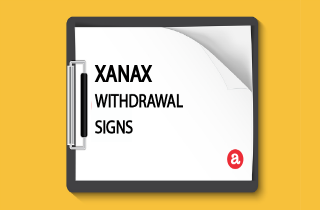The first signs of Xanax (alprazolam) withdrawal usually occur shortly after the medication has worn off in the system. The first signs mimic those of being sick. Feeling achy or like you are coming down a cold or stomach flu can signal the beginning of Xanax withdrawal. But what other signs can you look for? And when do you seek professional help for Xanax withdrawal symptoms treatment?
We review the early and later signs of Xanax withdrawal here. Then, we invite your questions about Xanax use or how to get help for Xanax addiction at the end.
Signs of Xanax withdrawal
Withdrawal is the result of your body developing a dependency on alprazolam. While Xanax dependence is an expected outcome after daily dosing for weeks at a time, if you are abusing or addicted to Xanax you can develop a quicker body dependence to Xanax. But because of the nature of benzodiazepine withdrawal, Xanax Withdrawal and Detox can take longer than withdrawal from opiates or other types of medications. In fact, Xanax withdrawal can fluctuate between severe and mild symptoms over the course of several weeks or months.
The onset of Xanax withdrawal symptoms appear 6-8 hours after the last dose has worn off. These symptoms will peak over the next 72 hours and should even out in about two weeks. At first, you may feel like you have withstood the worst of it only to find acute symptoms returning. These kinds of “rebound symptoms” take longer to fully resolve. It can takes weeks to months to before you are completely free of Xanax withdrawal symptoms such as anxiety, which may need to be addressed via behavioral therapy.
Withdrawal signs of Xanax can include:
- coma
- convulsions
- cramps
- depression
- diarrhea
- dysphoria
- fatigue
- fear
- headaches
- high blood pressure
- mania
- mood swings
- nausea
- psychosis
- restlessness
- seizures
- spasms
- vomiting
First signs of Xanax withdrawal
The first Signs of Xanax withdrawal will happen shortly after the medication has worn off. You can expect these withdrawal symptoms -vomiting, diarrhea, chills, aches and pains – to linger for the next couple of days and peak in severity before taking some time to resolve.
Also, you might exhibit signs of withdrawal that can be dangerous to your health. That is why it’s not recommended to withdrawal suddenly from any benzodiazepine drug like Xanax. And that you alwasy withdraw from Xanax under medical supervision. If serious signs of Xanax withdrawal occur, such as coma, seizures, convulsions, and psychosis…seek medical help immediately.
Early signs of Xanax withdrawal
Once you have gotten through the worst of withdrawal, signs of withdrawal can still continue to present themselves. While the worst of the flu like symptoms will ease up, you may continue to feel aches and pains, cramping, and spasms. You can also expect problems with your sleep,fatigue and needing to sleep more. You may also experience insomnia.
Other signs of withdrawal that can manifest are psychological in nature. Because Xanax is used to treat mood disorders, you can expect exacerbated symptoms of anxiety and depression to also appear. These signs will continue to arise throughout the process of withdrawal. They can also be the most frustrating and consuming withdrawal symptoms to deal with.
Late signs of Xanax withdrawal
Xanax withdrawal Signs show up and then wane. They can then again show up after several weeks after the initial withdrawal process. Most rebound withdrawal symptoms include continued psychological symptoms, discomfort, and trouble with sleep. These symptoms may also take a while to revolve and get better. If you are still suffering depression and anxiety then you will need to find a way to take care of it or address these disorders.
Signs and symptoms of Xanax withdrawal treatment
There are several ways you can treat the signs and symptoms of Xanax withdrawal. One of the easiest is to take address acute symptoms as they occur. There are over the counter medication that can help you with headaches, cramps, pain, and sleep if you are having a hard time sleeping or staying awake. Then there are medications that doctors can prescribe to help with withdrawal. Other antidepressants might be helpful to regulate the depression and anxiety you are feeling. It is important to be careful that medications to not interact negatively. Other benzodiazepines should not be used and avoiding depressants like alcohol are also important if you want to help and ease Signs of Xanax Withdrawal.
The biggest recommendation for treating signs of withdrawal is to taper doses of Xanax. The signs of withdrawal can be dangerous and unpredictable. Tapering is a way for you to work with your doctor to decrease the amount of Xanax in the body slowly over time. This method is one of the safest because it give the body time to regulate and heal itself now that Xanax is being taken from the body. This should help to minimize the intensity of withdrawal symptoms. You will still feel the resurgence of anxiety and depression and perhaps in a more manageable fashion then if you were to withdraw suddenly.
Other recommendations included observation or a treatment detox/facility. How do you treat Xanax addiction? If you are needing to withdrawal from Xanax out of necessity or are wanting to help manage withdrawal effects after abuse or addiction to the medication, supervision can help prevent serious complications from arising.
Xanax signs of withdrawal questions
Still have questions about Xanax withdrawal? We will get to them as soon as we can. Please leave your questions or comments in the section below.









Related Posts